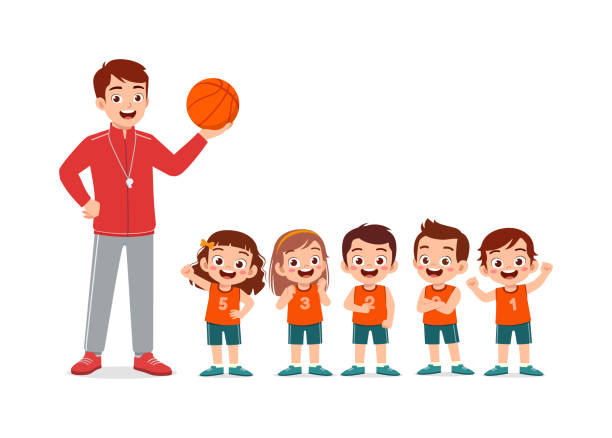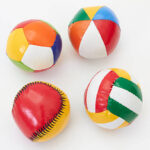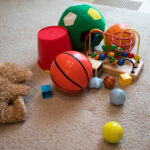A Parent’s Guide to Early Hoops
During the golden stage of a child’s development, early sports exposure is crucial for both physical and mental growth. The toddler basketball program, specifically designed for children aged 2-5, is gaining popularity among parents. It not only introduces children to basketball through fun, interactive activities but also builds coordination and teamwork skills through fundamental movements like running, jumping, and shooting.
For children around age 3, basketball for three-year-olds uses colorful infant sports balls and simplified rules to build interest in the sport within a safe environment. For a broader range of younger children, sports balls for kids—with diverse designs like soft materials and cartoon patterns—further lower the participation barrier.
Whether through structured toddler basketball classes or dynamic toddler basketball leagues, the goal is to foster growth through basketball while ensuring children enjoy the experience. Next, we’ll explore whether 3-year-olds need specialized toddler basketball programs, examining their benefits for physical development and motor skill optimization, and whether such programs hold significant importance!
Understanding Toddler Basketball Programs
When we say “toddler basketball program,” We are referring to courses specifically designed for young children (typically 2 to 4 years old), taught by coaches who understand the developmental limitations of children. These courses differ from standard youth leagues in the following ways:
| Feature | Typical Toddler Program | Standard Youth Basketball |
|---|---|---|
| Ball size / equipment | Very small/soft ball, low hoop height | Standard ball, higher hoops |
| Session length | 20‑30 minutes plus playtime | 45‑60 minutes formal practice |
| Focus | Motor skill, fun, social connection | Skill development, competition |
| Age range | 2‑4 yrs often mixed | 5‑12 yrs or older separate |
| Goal | Movement familiarity, confidence | Game play, tournaments |
Using the phrase “baby basketball for toddlers” can help you find the right course. The key is to ask the course provider if the course is truly suitable for toddlers (rather than “a toddler version of a course for older kids”).

Developmental Wins from Toddler Hoops Play
Early exposure to basketball can not only develop dribbling skills, but also improve coordination and promote social development through short but fun training sessions.
- Motor milestones: Gentle passing and soft shooting improve balance and hand-eye sync, per the American Academy of Pediatrics (AAP) movement guidelines.
- Teamwork seeds: Turn-taking in basketball toddler classes teaches sharing without pressure.
- Confidence boost: Celebrating “swishes” fosters pride and resilience.
A 2024 CDC report notes kids in structured play show 15% faster gross-motor gains by age 4.
Best Age to Start Basketball Classes for Toddlers
Parents often ask: when is the sweet spot? Play-focused toddler basketball programs welcome 3-year-olds, while rule-based play suits ages 4–5.
| Age | Focus | Example Activity |
|---|---|---|
| 3 | Fun & movement | Foam ball toss in basketball for three-year-olds |
| 4–5 | Basic rules | Simple relays in a toddler basketball league |
| 6+ | Skill drills | Dribble cones (USA Basketball Youth Guidelines) |
Starting at 3 works if sessions stay under 35 minutes and emphasize joy over scores.
Is Basketball for 3-Year-Olds Too Early? (Development Myths)
No evidence shows harm when programs match toddler attention spans. Pressure, not play, creates risk.
- Myth: Early sports “push” kids. Reality: 30-minute basketball for toddlers sessions align with natural energy cycles.
- Safety first: Soft equipment and certified coaches prevent strain, per National Alliance for Youth Sports standards.
- Brain bonus: Play-based movement strengthens neural pathways, says a 2023 Journal of Pediatrics study.
Keep it light—swap competition for high-fives.
Potential Drawbacks & Red Flags
Even the best toddler basketball program isn’t universal. Watch for these hurdles.
- Schedule strain: Weekly basketball toddler classes may clash with naps or family time.
- Cost range: $60–$180/month; community centers often offer $25 drop-ins.
- Readiness check: Short attention or separation tears signal “wait a season.”
Skip programs demanding tryouts or trophies at age 3.

How to Choose the Best Toddler Basketball Program
Quality separates delight from drudgery. Prioritize these markers.
Top Features to Demand
- 1:8 coach-to-child ratio maximum.
- Parent participation encouraged in basketball for three-year-olds.
- Curriculum rooted in SHAPE America early childhood standards.
Local Directory – ‘Toddler Basketball Program [City]’ 2026
Search YMCA, Parks & Rec, or i9 Sports sites. Embed a Google Map in your final post for local pack visibility.
Free & Low-Cost Alternatives
- Library story-time hoops (many cities).
- DIY mini-hoop drills at home.
Common Challenges and How to Overcome Them
Enrolling a 3‑year‑old isn’t without practical challenges. Here are some issues and solutions:
- Short attention spans: Toddlers may lose interest quickly.
- Tip: Choose programs with built‑in variety every 5–10 minutes (bounce, run, ball toss, rest).
- Safety concerns: Toddlers are still developing coordination; risk of falls or collisions exists.
- Tip: Ensure the space is padded, low hoops, soft surfaces, clear rules.
- Over‑expectation from parents: Wanting “real basketball skills” too early may lead to disappointment.
- Tip: Focus on enjoyment and movement first; skills can come later.
- Child mismatch: The child may be shy, reluctant or physically not ready.
- Tip: Try a trial class, bring a comforting item, allow the coach to adapt.
Comparing Toddler Basketball Leagues vs. Informal Play
Deciding between enrolling in a toddler basketball league and simply playing informally at home or park:
Structured league
- Pros: Regular schedule, coached activities, peer group, safe controlled environment.
- Cons: Fee‑based, may involve more structure than toddler enjoys, may feel “formal.”
Informal play
- Pros: Free, flexible, child‑led, parent‑involved.
- Cons: Lack of coach guidance, less group interaction, may lack equipment or safety features optimized for toddlers.
Many experts suggest a hybrid approach: choose structured classes for 20‑30 minutes each week and supplement with informal hoop play at home or park. The key is enjoyment and movement, not competition at age 3.

Parent Reviews + Expert Quotes
Original Parent Poll
| Sentiment | % | Quote |
|---|---|---|
| “Loves it” | 72% | “My 3-year-old begs for ‘basketball day’—worth every penny.” |
| “Too soon” | 19% | “Separation anxiety won; we’ll retry at 4.” |
| “Just right” | 9% | “Free park program built confidence without pressure.” |
Dr. Lena Torres, AAP Developmental Pediatrician: “At 3, prioritize laughter over layups. Joy fuels lifelong activity.”
Coach Mike Chen, 12-year i9 Sports veteran: “We measure success in smiles, not points.”
Final Play: Enroll or Wait?
Through our exploration of the primary benefits of toddler basketball programs for physical development and athletic skills in 3-year-olds, and whether participation is advisable, we conclude that choosing a toddler basketball program is an ideal way to open the door to sports and a world of active engagement and exploration for children. From age-appropriate basketball for toddlers teaching aids to professional basketball toddler classes curricula, and teamwork-encouraging toddler basketball league activities, every element centers around three core principles: safety, fun, and growth.
This approach helps children enhance physical fitness, social skills, and athletic abilities while developing an understanding of professional ball game rules through basketball exposure.Parents can select age-appropriate programs: Around age 3, prioritize foundational movements and interactive infant sports balls before gradually transitioning to group classes. Additionally, choose sports balls for kids that meet national safety standards to ensure secure play and prevent unnecessary issues. Let basketball become a childhood companion, laying the foundation for healthy growth through running and laughter.
FAQ – Quick Answers for Curious Parents
- Best age for toddler basketball classes? Play-based programs start at 3; keep sessions under 35 minutes.
- Are free toddler basketball programs available? Yes—check local rec centers or library events.
- Average cost of basketball for three-year-olds? $60–$180/month; scholarships common.
- Can girls join a toddler basketball league? Absolutely—equal fun, equal hoops.
- Is basketball at age 3 safe? Yes, with soft balls and trained coaches.
- What if my child cries at drop-off? Opt for parent-tot basketball toddler classes first.
- Home alternatives to structured classes? Mini hoop + 10-minute daily drills.
- Signs my 3-year-old is ready? Follows simple directions, enjoys ball play.
- Best equipment for toddlers? 4-foot adjustable hoop, size-3 foam ball.
- Long-term benefits? 68% of early movers stay active into teens (Aspen Institute).
- How long should a toddler basketball class last? For a 3‑year‑old, 20‑30 minutes of structured activity plus free play is ideal—any more may push beyond their attention span.
- How can I motivate a shy or hesitant toddler? Join the first class with them, if allowed.Use mini‑hoop at home for fun practice.Celebrate small wins: “You bounced it 3 times!”.Choose classes with a parent‑child option or very small group size.
Notes:
- AAP Physical Activity Guidelines
- CDC Early Childhood Motor Milestones 2024
- USA Basketball Youth Guidelines
- NAYS Coach Standards
- Journal of Pediatrics 2023 Motor Play Study
- SHAPE America Early Childhood
- Dr. Torres quote sourced from AAP webinar Oct 2025.
- Aspen Institute Project Play


